(完整word版)非谓语动词作状语的用法
非谓语动词作状语用法
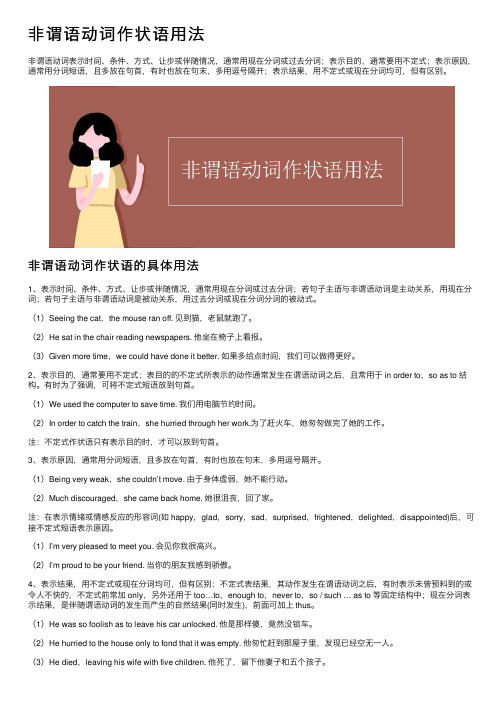
⾮谓语动词作状语⽤法⾮谓语动词表⽰时间、条件、⽅式、让步或伴随情况,通常⽤现在分词或过去分词;表⽰⽬的,通常要⽤不定式;表⽰原因,通常⽤分词短语,且多放在句⾸,有时也放在句末,多⽤逗号隔开;表⽰结果,⽤不定式或现在分词均可,但有区别。
⾮谓语动词作状语的具体⽤法1、表⽰时间、条件、⽅式、让步或伴随情况,通常⽤现在分词或过去分词;若句⼦主语与⾮谓语动词是主动关系,⽤现在分词;若句⼦主语与⾮谓语动词是被动关系,⽤过去分词或现在分词分词的被动式。
(1)Seeing the cat,the mouse ran off. 见到猫,⽼⿏就跑了。
(2)He sat in the chair reading newspapers. 他坐在椅⼦上看报。
(3)Given more time,we could have done it better. 如果多给点时间,我们可以做得更好。
2、表⽰⽬的,通常要⽤不定式;表⽬的的不定式所表⽰的动作通常发⽣在谓语动词之后,且常⽤于 in order to,so as to 结构。
有时为了强调,可将不定式短语放到句⾸。
(1)We used the computer to save time. 我们⽤电脑节约时间。
(2)In order to catch the train,she hurried through her work.为了赶⽕车,她匆匆做完了她的⼯作。
注:不定式作状语只有表⽰⽬的时,才可以放到句⾸。
3、表⽰原因,通常⽤分词短语,且多放在句⾸,有时也放在句末,多⽤逗号隔开。
(1)Being very weak,she couldn’t move. 由于⾝体虚弱,她不能⾏动。
(2)Much discouraged,she came back home. 她很沮丧,回了家。
注:在表⽰情绪或情感反应的形容词(如 happy,glad,sorry,sad,surprised,frightened,delighted,disappointed)后,可接不定式短语表⽰原因。
非谓语动词作定语和状语

A A. add B. to add C. adding D. added
3). The disc, digitally ______ in the studio, sounded fantastic at the party that night.
A. recorded
B. recording
C. to be recorded D. being recorded
C Figure” award, a title _____ to ordinary
people for their contributions to
environmental protection.
A. being given B. is given
C. given
D. was given
不定式(to do)
②The question _b_e_i_n_g__d_is_c_u_s_s_e(ddiscuss) at the
meeting now is of quite importance.
③The question __t_o_b_e__d_i_s_cu__s_se_d(discuss) at the
meeting tomorrow is of quite importance.
A. are bought
B. bought
C. have been bought D. buying
解析:此题学生最易错选的答案为A或C。依据上面 陈述,填入A或C句子都有两个谓语动词,而此 处两个动词并非并列谓语,也不是分别出现在主 从句中,故答案有误。该题正确答案为B, bought through a computer为一过去分词短语作后 置定语,句中只有一个谓语can be lower than。当 然此题如改为Prices of daily goods which have been bought through…也是正确的,因为这一动 作出现在从句中。
非谓语动词作状语的用法

非谓语动词作状语的用法介绍非谓语动词是指不具有人称和数的动词形式,例如动词的不定式、动名词和现在分词。
它们在句子中常常用作状语,用来修饰或者补充说明动作或状态的情况。
本文将介绍非谓语动词作状语的用法。
不定式作状语不定式作状语常使用 to + 动词原形的形式,可以表示目的、结果、原因、方式等。
例如:- 目的:He went to the store to buy some groceries.- 结果:She ran fast to catch the bus.- 原因:I walked slowly to avoid slipping on the icy road.- 方式:He spoke softly to not disturb the sleeping baby.动名词作状语动名词作状语常使用动词 + -ing 的形式,可以表示原因、方式、条件、时间等。
例如:- 原因:She failed the test by not studying enough.- 方式:They solved the problem by working together.- 条件:You can improve your English by practicing regularly.- 时间:She finished the project by staying up all night.现在分词作状语现在分词作状语常使用动词 + -ing 的形式,可以表示原因、时间、条件等。
例如:- 原因:Feeling hungry, he decided to go out for dinner.- 时间:Waiting for the train, she listened to music.- 条件:Being late, he missed the beginning of the movie.注意事项1. 非谓语动词作状语时,要注意逻辑关系和修饰对象的一致性。
非谓语动词做状语方法

非谓语动词做状语方法非谓语动词是指在句子中充当动词的形式,但不具备时态等谓语动词的特征。
非谓语动词主要有动词不定式、动名词和分词三种形式。
在句子中,非谓语动词可以充当状语,对动作或状态进行修饰和补充,使句子更加丰富和准确。
下面将介绍几种常见的非谓语动词做状语的方法。
一、动词不定式做状语动词不定式是由“to + 动词原形”构成的形式,在句子中可以作为状语来修饰动作或状态。
常见的动词不定式做状语的用法有以下几种:1. 作目的状语动词不定式可以表示动作的目的或出发点,常用的短语有“in order to”、“so as to”、“to”等。
例如:- I went to the supermarket to buy some groceries.- He studied hard in order to pass the exam.2. 作结果状语动词不定式可以表示动作的结果或后果,常用的短语有“so as to”、“to”等。
例如:- She ran fast to catch the bus.- He worked hard to earn more money.动词不定式可以表示动作的方式,常用的短语有“to”、“in order to”等。
例如:- They danced together to celebrate the victory.- He spoke loudly to make himself heard.4. 作原因状语动词不定式可以表示动作的原因,常用的短语有“for”、“to”等。
例如:- She apologized to him for being late.- He thanked her for helping him.二、动名词做状语动名词是由动词加上-ing构成的名词形式,具有动词和名词的特点,可以作为状语来修饰动作或状态。
常见的动名词做状语的用法有以下几种:1. 作原因状语动名词可以表示动作的原因,常用的短语有“by”、“by means of”等。
非谓语动词在句子中作状语和作宾语补足语的不同用法
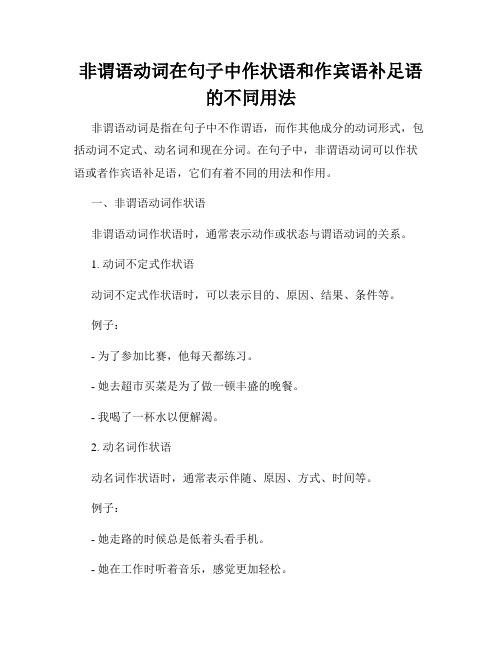
非谓语动词在句子中作状语和作宾语补足语的不同用法非谓语动词是指在句子中不作谓语,而作其他成分的动词形式,包括动词不定式、动名词和现在分词。
在句子中,非谓语动词可以作状语或者作宾语补足语,它们有着不同的用法和作用。
一、非谓语动词作状语非谓语动词作状语时,通常表示动作或状态与谓语动词的关系。
1. 动词不定式作状语动词不定式作状语时,可以表示目的、原因、结果、条件等。
例子:- 为了参加比赛,他每天都练习。
- 她去超市买菜是为了做一顿丰盛的晚餐。
- 我喝了一杯水以便解渴。
2. 动名词作状语动名词作状语时,通常表示伴随、原因、方式、时间等。
例子:- 她走路的时候总是低着头看手机。
- 她在工作时听着音乐,感觉更加轻松。
- 他生气时喜欢一个人静静地待在房间里。
3. 现在分词作状语现在分词作状语时,通常表示时间、原因、结果、条件等。
例子:- 孩子们坐在河边嬉戏的时候,天空中飞过一只小鸟。
- 雨停了,她放下伞继续前行。
- 他跑得太快,以至于摔倒在地。
二、非谓语动词作宾语补足语非谓语动词作宾语补足语时,通常与及物动词或介词搭配使用,用来修饰宾语。
1. 动词不定式作宾语补足语动词不定式作宾语补足语时,通常表示动作的结果或目的。
例子:- 她希望能赚到更多的钱。
- 他们需要找到一个解决问题的方法。
- 我喜欢把房间布置得温馨舒适。
2. 动名词作宾语补足语动名词作宾语补足语时,通常表示动作的结果、原因、方式等。
例子:- 他喜欢听别人讲故事。
- 她害怕看到血液。
- 我对你的成功感到骄傲。
3. 现在分词作宾语补足语现在分词作宾语补足语时,通常表示动作的结果、方式等。
例子:- 孩子们使整个教室变得非常吵闹。
- 她发现这个问题变得越来越困难。
- 他的话让她感到非常惊讶。
总结起来,非谓语动词在句子中作状语时表示动作与谓语的关系,可以使用动词不定式、动名词和现在分词。
非谓语动词作宾语补足语时则用来修饰宾语,常见的形式有动词不定式、动名词和现在分词。
(完整版word)非谓语动词的用法大全及答案
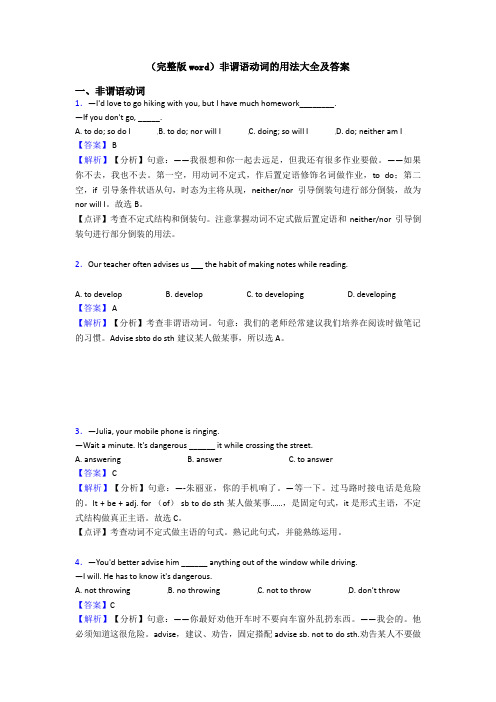
(完整版word)非谓语动词的用法大全及答案一、非谓语动词1.—I'd love to go hiking with you, but I have much homework________.—If you don't go, _____.A. to do; so do IB. to do; nor will IC. doing; so will ID. do; neither am I【答案】 B【解析】【分析】句意:——我很想和你一起去远足,但我还有很多作业要做。
——如果你不去,我也不去。
第一空,用动词不定式,作后置定语修饰名词做作业,to do;第二空,if 引导条件状语从句,时态为主将从现,neither/nor引导倒装句进行部分倒装,故为nor will I。
故选B。
【点评】考查不定式结构和倒装句。
注意掌握动词不定式做后置定语和neither/nor引导倒装句进行部分倒装的用法。
2.Our teacher often advises us the habit of making notes while reading.A. to developB. developC. to developingD. developing【答案】 A【解析】【分析】考查非谓语动词。
句意:我们的老师经常建议我们培养在阅读时做笔记的习惯。
Advise sbto do sth建议某人做某事,所以选A。
3.—Julia, your mobile phone is ringing.—Wait a minute. It's dangerous ______ it while crossing the street.A. answeringB. answerC. to answer【答案】 C【解析】【分析】句意:—-朱丽亚,你的手机响了。
—等一下。
过马路时接电话是危险的。
It + be + adj. for (of) sb to do sth 某人做某事……,是固定句式,it是形式主语,不定式结构做真正主语。
非谓语动词做状语

二. done/being done/having been done 做状语 主语与非谓语动词之间为被动关系; having been done 发生在主句谓语动词之前
1. Seen from the top of the mountain, the city looks beautiful.
2. Compared with those who lived in the slums, Children here are really lucky.
过去分词可以以下成分:
1.表语 The teacher is moved. 2. 定语 I don’t like the man talked about at the party. 3. 宾补 We heard a song sung in her room. 4. 状语 Lost in a newspaper, She didn’t notice me.
He is too careful not to have noticed that. 他那么小心,肯定会注意到那一点的。 She is too sad not to help crying. 她那么伤心,忍不住哭了。 I am only too glad to help you.我很高兴能帮助你。 I am only never too glad to know you. 认识你我再高兴不过了。
s )
一. 非谓语动词做状语的形式: 二. doing/ having done 三. done/being done/having been done 四. to do/ to be done
五. 二. 做题方法:析句子结构,找逻辑主语, 辩逻辑关系,判动词先后
If I am given more time, I’ ll catch up with you.
非谓语动词做状语

3. Discuss them with your partners, then answer the following questions and fill them in the form. 1. 非谓语动词的什么形式做状语? 2. 非谓语动词与主语之间的关系? 3. 一,二类大题中的非谓语动词与谓语动词 的先后顺序
(四)判动词先后
Following the old man, the young people 1.________ started walking slowly. A.Followed B. Following C. To follow D. Having followed 2.Having ______________ the fruit, the girl became swallowed pregnant and gave a birth to a handsome boy. A.Having swallowed B. Swallowing C. To swallow
主语 谓语 宾
The girl dancing in the hall is Mary. Given more time, I’ll catch up with you.
非谓语动Байду номын сангаас (状语)
观察下列例句, 找出非谓语动词, 并且判断做 什么成分 (时间状语 )
1. Asked why he did it, he said it was his duty. 2. Being ill, he didn’t go to school. (原因状语) 3. Working hard, you will do well in your exams.
非谓语动词,不是做谓语的动词。当句中已经有了谓语 Analyze the sentence:划分句子结构 动词,并且句中没有连词时,需要用非谓语动词了。
高考英语之非谓语动词作状语
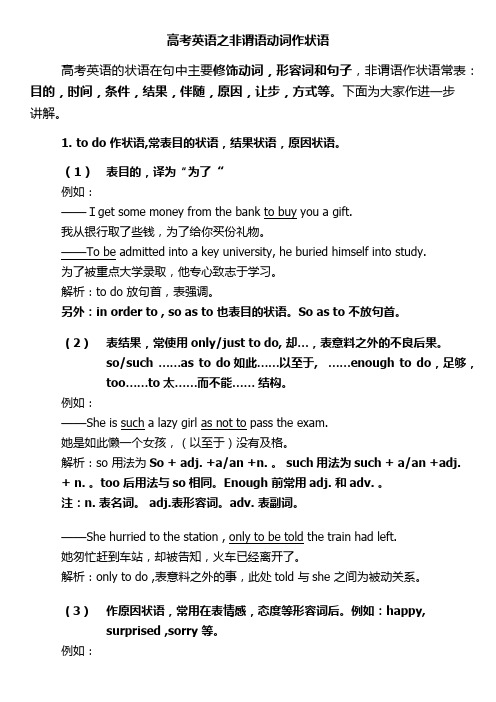
高考英语之非谓语动词作状语高考英语的状语在句中主要修饰动词,形容词和句子,非谓语作状语常表:目的,时间,条件,结果,伴随,原因,让步,方式等。
下面为大家作进一步讲解。
1.to do 作状语,常表目的状语,结果状语,原因状语。
(1)表目的,译为“为了“例如:——Iget some money from the bank to buy you a gift.我从银行取了些钱,为了给你买份礼物。
——To be admitted into a key university, he buried himself into study.为了被重点大学录取,他专心致志于学习。
解析:to do 放句首,表强调。
另外:in order to , so as to 也表目的状语。
So as to 不放句首。
(2)表结果,常使用only/just to do, 却…,表意料之外的不良后果。
so/such ……as to do如此……以至于, ……enough to do,足够,too……to太……而不能……结构。
例如:——She is such a lazy girl as not to pass the exam.她是如此懒一个女孩,(以至于)没有及格。
解析:so 用法为So + adj. +a/an +n. 。
such用法为such + a/an +adj.+ n. 。
too 后用法与so相同。
Enough 前常用adj. 和adv. 。
注:n. 表名词。
adj.表形容词。
adv. 表副词。
——She hurried to the station , only to be told the train had left.她匆忙赶到车站,却被告知,火车已经离开了。
解析:only to do ,表意料之外的事,此处told 与she 之间为被动关系。
(3)作原因状语,常用在表情感,态度等形容词后。
例如:happy,surprised ,sorry 等。
非谓语动词作状语的用法
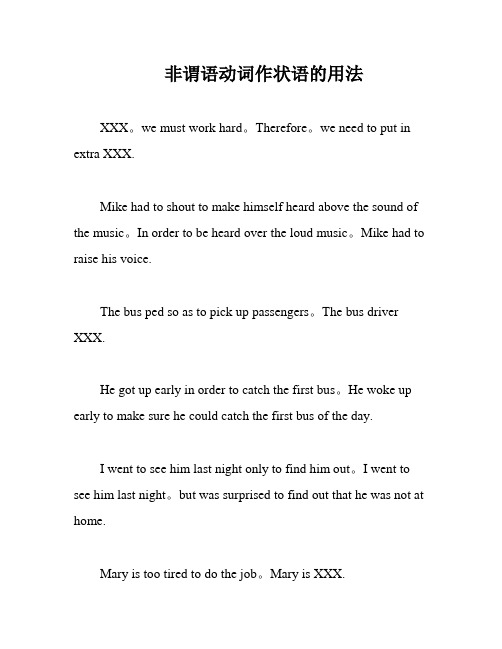
非谓语动词作状语的用法XXX。
we must work hard。
Therefore。
we need to put in extra XXX.Mike had to shout to make himself heard above the sound of the music。
In order to be heard over the loud music。
Mike had to raise his voice.The bus ped so as to pick up passengers。
The bus driver XXX.He got up early in order to catch the first bus。
He woke up early to make sure he could catch the first bus of the day.I went to see him last night only to find him out。
I went to see him last night。
but was surprised to find out that he was not at home.Mary is too tired to do the job。
Mary is XXX.He is old enough to go to school。
He has reached the age where he is XXX.Tom was very happy to see his mother。
When Tom saw his mother。
he was filled with joy.I was surprised to find him here。
I was taken aback when I discovered that he was present.English is an easy language to learn。
(完整版word)非谓语动词用法总结附解析

(完整版word)非谓语动词用法总结附解析一、非谓语动词1.It was raining. My father asked me _______ a raincoat.A. takeB. takesC. tookD. to take【答案】 D【解析】【分析】句意:正下雨。
我父亲要我带上雨衣。
根据关键词 asked me,再结合选项,可判断出此处考查的是 ask sb. to do sth.的用法,故答案选 D。
【点评】考查固定搭配ask sb. to do sth.。
2.Our teacher often advises us the habit of making notes while reading.A. to developB. developC. to developingD. developing【答案】 A【解析】【分析】考查非谓语动词。
句意:我们的老师经常建议我们培养在阅读时做笔记的习惯。
Advise sbto do sth建议某人做某事,所以选A。
3.My mother doesn't allow me _______outside too late on school nights.A. to stayB. stayC. staying【答案】 A【解析】【分析】句意:在上学的日子里,我妈妈不允许我在外面待得太晚。
Allow sb to dosth允许某人做某事,是固定用法,故答案选A。
【点评】考查动词不定式,掌握固定搭配。
4.Nowadays,most people prefer to________ computer games rather than ___________ books.A. play;readingB. play;readC. playing; reading【答案】 B【解析】【分析】句意:现在,大部分人比起读书更喜欢玩电脑游戏。
prefer to doA rather than do B比起B更喜欢做A。
非谓语动词用法解析过去分词作状语

非谓语动词用法解析过去分词作状语非谓语动词用法解析——过去分词作状语过去分词作为一种非谓语动词形式,在英语语法中扮演着重要的角色。
它可以作为状语,修饰动词、形容词以及副词,起到更加精确和丰富的表达作用。
本文将对过去分词作状语的用法进行解析,并举例说明其在不同语境下的运用。
1. 过去分词作时间状语过去分词可以表示一个动作或状态的发生时间,常用于表示被动或完成的行为。
这种用法通常与表示时间的介词短语(如"after"、"before"、"since"、"when"、"while"等)搭配使用。
例1:Having finished her work, she went out for a walk.(完成了工作后,她出去散步了。
)例2:After being repaired, the car was as good as new.(修好后,这辆车好像新的一样。
)2. 过去分词作原因状语过去分词也可以表示一个动作或状态的原因。
它常用于表示被动、先行动作和结果的关系,通常与表示原因的介词短语(如"because of"、"due to"、"thanks to"等)搭配使用。
例1:Because of the heavy rain, the game was canceled.(因为下大雨,比赛被取消了。
)例2:Due to his hard work, he achieved great success.(由于他的努力,他取得了巨大的成功。
)3. 过去分词作方式状语过去分词还可以表示一个动作的方式或方式。
它常与表示方式的介词短语(如"by")或连词(如"as")搭配使用。
例1:He won the race by running faster than others.(他通过比其他人跑得更快赢得了比赛。
非谓语做状语的用法

非谓语做状语的用法非谓语动词可以作状语有四种主要用法:1)动词现在分词和过去分词表示时间、条件方式让步或伴随的状况:这个用法中,如果句子主语与非谓语动词是主动关系,我们要用现在分词。
若句子主语与非谓语动词是被动关系,就要使用过去分词或现代分词的被动式。
例:The crowd dispersed, chattering still about the shocking scene. 人群渐渐散去,路上人们还小声谈论着那惊人的场景。
2)动词不定式作目的状语:动词的不定式形式可以单独使用表目的,也可用在短语so as to do sth.或in order to do sth.之类里面。
如果这类的目的状语用在句首,通常后面需要加一个逗号隔开。
如:To win the election, he must make sure that the citizens support his vision for urban development. 想要赢得选举,他必须确保市民们支持他的城市发展愿景。
3)分词短语表示原因:非谓语动词作状语的这个用法可以置于句首,也可以放在句末,多用逗号隔开。
如:Seeing the effectiveness of mask wearing for preventing the spread of COVID, many European countries also started enforcing the use of masks. 看到戴口罩对预防新冠肺炎传播的有效性,许多欧洲国界也开始增强对口罩使用的要求。
4)不定式或现在分词表示结果:这两者分别在于不定式表示结果,其动作发生在谓语动词之后,有时表示未曾预料或令人不愉快的,不定式前常加only;现在分词表示结果,是伴随谓语动词的发生而产生的自然结果。
例如:He rushed to his office, only to realise that it was a public holiday. 他急忙赶到了他的办公室,才想起来那天是公共假日。
非谓语动词作状语的用法
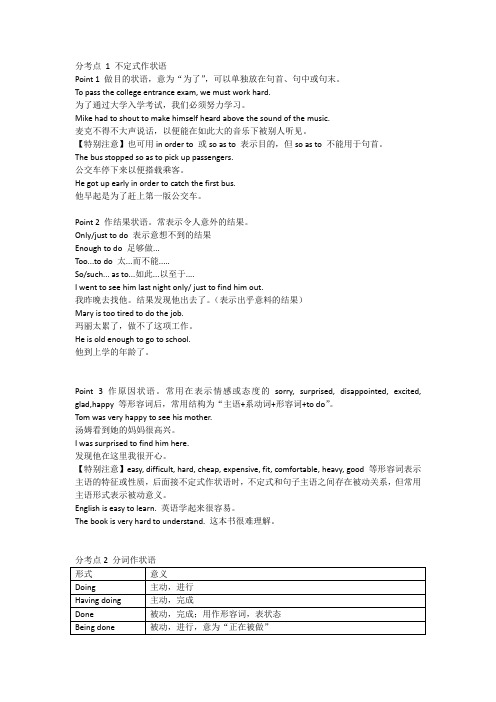
分考点1 不定式作状语Point 1 做目的状语,意为“为了”,可以单独放在句首、句中或句末。
To pass the college entrance exam, we must work hard.为了通过大学入学考试,我们必须努力学习。
Mike had to shout to make himself heard above the sound of the music.麦克不得不大声说话,以便能在如此大的音乐下被别人听见。
【特别注意】也可用in order to 或so as to 表示目的,但so as to 不能用于句首。
The bus stopped so as to pick up passengers.公交车停下来以便搭载乘客。
He got up early in order to catch the first bus.他早起是为了赶上第一版公交车。
Point 2 作结果状语。
常表示令人意外的结果。
Only/just to do 表示意想不到的结果Enough to do 足够做...Too...to do 太...而不能.....So/such... as to...如此...以至于....I went to see him last night only/ just to find him out.我昨晚去找他。
结果发现他出去了。
(表示出乎意料的结果)Mary is too tired to do the job.玛丽太累了,做不了这项工作。
He is old enough to go to school.他到上学的年龄了。
Point 3 作原因状语。
常用在表示情感或态度的sorry, surprised, disappointed, excited, glad,happy 等形容词后,常用结构为“主语+系动词+形容词+to do”。
Tom was very happy to see his mother.汤姆看到她的妈妈很高兴。
非谓语动词做状语在写作中的应用

非谓语动词做状语在写作中的应用非谓语动词包括动词不定式、动名词和分词(现在分词和过去分词),它们在写作中做状语时可以丰富句子表达,增强文采。
一.动词不定式做状语1.目的状语可以用来表示目的,常放于句首或句末。
例如,“To improve my English, I read English novels every day.”(为了提高我的英语水平,我每天读英语小说),这里的“To improve my English”表明了读书这个行为的目的。
在句尾时,如“I get up early to catch the first bus.”(我早起是为了赶上头班车)。
2.结果状语常与“only”连用,表示出乎意料的结果。
例如,“He rushed to the station only to find the train had left.”(他匆忙赶到车站,结果却发现火车已经开走了)。
二.现在分词做状语1.时间状语当分词的动作与主句的动作同时发生时,可以用现在分词作时间状语。
例如,“Walking in the park, I met an old friend.”(在公园里散步的时候,我遇到了一位老朋友),“Walking in the park”这个动作和“met an old friend”同时发生。
2.原因状语表原因,相当于一个原因状语从句。
如“Being ill, he didn't go to school.”(因为生病了,他没去上学),这里“Being ill”是他没去上学的原因。
3.伴随状语表示伴随状况,与主句的动作同时进行。
比如,“The girl sat there, reading a book.”(女孩坐在那儿,读着一本书),“reading a book”伴随“sat”这个动作。
过去分词做状语1.时间状语和现在分词类似,当过去分词表示的动作先于主句动作时,可作时间状语。
非谓语动词作定语,状语,宾语总结

非谓语动词作定语, 状语,宾语
非谓语动词作宾语
Hale Waihona Puke 1.只接to do作宾语的动词:consider(考虑) forgive,want,demand等 2.只接doing作宾语的动词:appreciate, avoid,risk,mind,feel like等 3.接to do或doing作宾语意义大不同的动词: Remember,forget,regret等
非谓语作状语,作定语
1.基本原则:三句话 2.先语态后时态-语态上 (1)非谓作状语:看非谓与主句主语之间的 主被动; (2)非谓作定语:看非谓与所修饰名词之间 的主被动
非谓语作状语,作定语 先语态后时态-时态上 看非谓与主句谓语动词发生的先后顺序: 若非谓发生在主句谓语动词之前,用完成时 having done,having been done 若非谓发生在主句谓语动词之后或同时,用 to do 若非谓与主句谓语动词同时发生,用 doing/being done
非谓语动词作状语用法详解
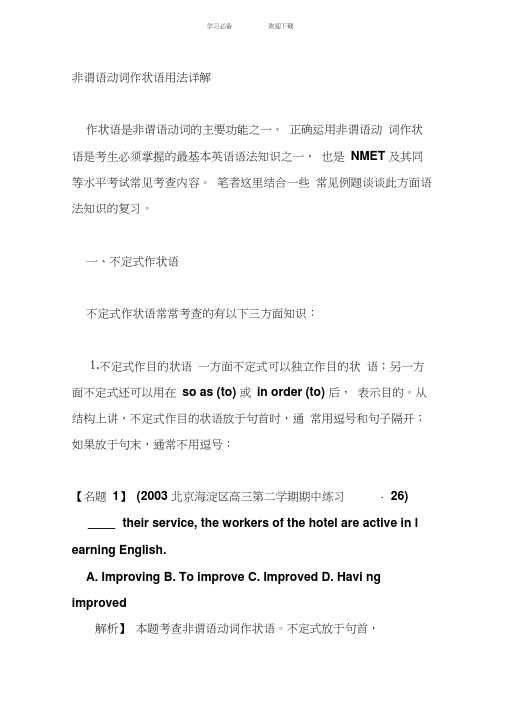
非谓语动词作状语用法详解作状语是非谓语动词的主要功能之一。
正确运用非谓语动词作状语是考生必须掌握的最基本英语语法知识之一,也是NMET 及其同等水平考试常见考查内容。
笔者这里结合一些常见例题谈谈此方面语法知识的复习。
一、不定式作状语不定式作状语常常考查的有以下三方面知识:⒈不定式作目的状语一方面不定式可以独立作目的状语;另一方面不定式还可以用在so as (to) 或in order (to) 后,表示目的。
从结构上讲,不定式作目的状语放于句首时,通常用逗号和句子隔开;如果放于句末,通常不用逗号:【名题1】(2003 北京海淀区高三第二学期期中练习· 26) ____ their service, the workers of the hotel are active in l earning English.A. ImprovingB. To improveC. ImprovedD. Havi ng improved解析】本题考查非谓语动词作状语。
不定式放于句首,说明了酒店员工积极学习英语的目的。
答案为B。
【名题2】(2003 北京东城区高三总复习练习(一) · 26)_____ time and labour, cartoonists generally draw the ha nds of their characters with only three fingers and a thumb. A. To save B. Saved C. Saving D. Having saved【解析】本题考查非谓语动词作状语。
不定式放于句首,说明了漫画家在画人物的手指时为什么只画三个手指和一个大拇指。
答案为A 。
名题3】( '99SHMET · 18)—Mum. Why do you always make me eat an egg every da y?—_____ enough protein and nutrition as you are growing up.A. GetB. GettingC. To getD. To be【解析】本题考查非谓语动词作状语。
(完整word)非谓语动词作状语全解讲解

非谓语动词作状语全解不定式和分词作状语的用法一、不定式作状语可以作:1。
主要用作目的状语。
常与 in order to do (为了或 so as to do(以便连用。
so as to 不用于居首。
He got up early in order to catch the first bus. 他早起为了赶上第一班车。
He sat down to have a rest。
他坐下来休息。
He went to France to learn French. 他去法国学习法语.They stood by the roadside to talk about the plan.他们站在路边为的是谈论这个计划。
They stopped to ask the way. 他们停下来问路. (停下来的目的2。
作结果状语。
表示出乎意料的结果。
做结果状语的不定式只能出现在句子的末尾,常见的不定式动词有:to find, to hear, to see, to be told, to form, to give, to make,to produce 等。
He hurried to the station only to find the train gone. 他匆匆忙忙地赶到火车站,发现火车已经开走了.He woke up to find everybody gone。
他醒来发现大家都走了。
His family was too poor to support him。
他的家庭太穷,不能维持他的生活. The boy is not tall enough to reach the book shelf。
这男孩个子不够高, 手伸不到书架。
He is old enough to go to school。
他到上学年龄了.He lifted a rock only to drop it on his own feet.他搬起石头砸了自己的脚。
非谓语状语

非谓语状语非谓语动词指的是在句子中不做谓语的动词,主要包括不定式、动名词、现在分词和过去分词。
如果句子中已经有了谓语动词,并且没有连词,那么其他的动词就需要用非谓语形式。
可以做状语的非谓语形式有动词分词、不定式。
非谓语动词做状语有以下几种用法:1.分词做状语分词有现在分词和过去分词,根据动作与主语的关系决定;另外还有各种时态,根据动作发生的时间和顺序决定(doing, having done, done, being done, having been done)。
当主语与非谓语动词为主动关系时,非谓语动词用现在分词形式,如果动作发生在主句谓语之前则用having done的形式。
当主语和非谓语动词为被动关系时,非谓语动词用过去分词形式。
(1)时间状语:Working in the factory,he was an advanced worker.在工厂工作时,他是一名先进工人。
When completed, the road will be open to the public. 这条路在竣工后会正式通车。
(2)方式状语(表示伴随):He sat in the chair reading newspapers. 他坐在椅子上看报。
She came into the office, followed by her assistant. 她走进办公室,身后跟着她的助理。
(3)原因状语:Seeing the cat, the mouse ran off. 见到猫,老鼠就跑了。
Defeated by his desk mate, he felt discouraged. 由于被同桌打败,他感到气馁。
(4)条件状语:You won’t pass the exam playing computer games all day. 这样整天玩电脑游戏你是不会通过考试的。
Given more time, I can pass the exam. 如果多给我点时间,我会通过考试的。
非谓语作状语结构

非谓语作状语结构非谓语动词,顾名思义就是不作谓语的动词本质上也是由动词变过来的,但是为了区别它与动词,就在它的形式上与动词有区别。
非谓语动词有三种变形to do 也就是不定式doing 现在分词/动名词done过去分词按照大体的词性,可以分成三类,动名词,不定式,分词(过去分词和现在分词)非谓语在句中的作用就是做除谓语以外的其他句子成分,如主语,宾语,表语,宾补,状语,定语,同位语。
非谓语作状语的知识如下:状语,是用来修饰动词,形容词,副词以及句子的原因,方式,时间,地点,目的,程度,等等等。
非谓语只有分词和不定式可以作状语,(动名词不能做状语,顾名思义动名词,把动词变成名词的性质,那就相当于一个名词,名词是不能做状语的。
一般常见做状语的是副词。
)先说不定式作状语表原因,目的,结果(谐音记忆:不(不定式)状(状语),因目果意思就是,为什么不说话,因为我的眼睛只有苹果)〔1〕不定式作原因状语关键点是:基本结构中的主系表,表语是有表示心情状态形容词充当,如:开心,伤心……例:I am so happy to see you.因为见到你我很高兴〔2〕不定式作目的状语这个不用我说,大家一看到不定式,最开始想的就是目的状语例:I study hard to server people well.我努力学习是为了更好地服务人民。
〔3〕不定式作结果状语关键点:意料之外的结果例:I hurried to school, only to find the gate locked.我急急忙忙去学校,结果发现门锁了。
分词作状语〔主动用doing,被动用done〕表原因,条件,时间,让步,方式,伴随,结果。
〔谐音巧记:因挑食(时间)让柿(方式)拌着果〕〔1〕分词作原因状语例:Being ill, he didn't go to school.因为生病了,他没去学校。
主语是he,他与ill的关系是他生病,主动,用现在分词。
- 1、下载文档前请自行甄别文档内容的完整性,平台不提供额外的编辑、内容补充、找答案等附加服务。
- 2、"仅部分预览"的文档,不可在线预览部分如存在完整性等问题,可反馈申请退款(可完整预览的文档不适用该条件!)。
- 3、如文档侵犯您的权益,请联系客服反馈,我们会尽快为您处理(人工客服工作时间:9:00-18:30)。
分考点1 不定式作状语Point 1 做目的状语,意为“为了”,可以单独放在句首、句中或句末。
To pass the college entrance exam, we must work hard.为了通过大学入学考试,我们必须努力学习。
Mike had to shout to make himself heard above the sound of the music.麦克不得不大声说话,以便能在如此大的音乐下被别人听见。
【特别注意】也可用in order to 或so as to 表示目的,但so as to 不能用于句首。
The bus stopped so as to pick up passengers.公交车停下来以便搭载乘客。
He got up early in order to catch the first bus.他早起是为了赶上第一版公交车。
Point 2 作结果状语。
常表示令人意外的结果。
Only/just to do 表示意想不到的结果Enough to do 足够做...Too...to do 太...而不能.....So/such... as to...如此...以至于....I went to see him last night only/ just to find him out.我昨晚去找他。
结果发现他出去了。
(表示出乎意料的结果)Mary is too tired to do the job.玛丽太累了,做不了这项工作。
He is old enough to go to school.他到上学的年龄了。
Point 3 作原因状语。
常用在表示情感或态度的sorry, surprised, disappointed, excited, glad,happy 等形容词后,常用结构为“主语+系动词+形容词+to do”。
Tom was very happy to see his mother.汤姆看到她的妈妈很高兴。
I was surprised to find him here.发现他在这里我很开心。
【特别注意】easy, difficult, hard, cheap, expensive, fit, comfortable, heavy, good 等形容词表示主语的特征或性质,后面接不定式作状语时,不定式和句子主语之间存在被动关系,但常用主语形式表示被动意义。
English is easy to learn. 英语学起来很容易。
The book is very hard to understand. 这本书很难理解。
Point 1 作时间状语,常用在when,while,before,since,as引导的原因状语从句中。
He went through the papers while having breakfast(= while he was having breakfast).他边吃早饭边看报纸。
When completed(= when it is completed), the road will be open to the public.这条路在竣工后会正式通车。
Point 2 作原因状语,相当于because,since,as 引导的原因状语从句。
Not understanding this, he asked the teacher about.= Because he didn’t understand this,he asked the teacher about it.因为不理解,关于那个问题他问了老师。
Defeated by his desk mate, he felt discouraged.= Because he was defeated by his desk mate, he felt discouraged. 由于被同桌打败,他感到气馁。
Point 3 作条件状语,相当于if,unless引导的条件状语从句。
Working hard, you’ll succeed. = If you work hard, you will succeed.如果努力学习,你会成功的。
Given more time, I can finish the work. = If I am given more time, I can finish the work.如果多给我点时间,我就能完成这项工作。
Point 4 作结果状语。
常用现在分词表示自然而然的结果,分词前可接thus。
Their car was caught in a traffic jam, thus causing the delay.他们的车被困在拥挤的交通中,因此耽搁了时间。
The fire lasted nearly a month, leaving nothing valuable.大火持续了近一个月,几乎没剩下什么有价值的东西。
【特别注意】过去分词一般不作结果状语。
Point 5 作方式或伴随状语。
He made the boy sit there, promising he would not hurt him.他让那个小男孩坐在那边,答应不伤害他。
The teacher came into the lab, followed by some students.老师走进实验室,身后跟着一些学生。
(伴随状语)Point 6 作让步状语,相当于though,although,even if等引导的让不状语从句。
Warned of the danger, he still went skating on the thin ice. = Though he was warned of the danger, he still went skating on the thin ice.尽管被警告危险,他依旧在薄冰上滑冰。
Lacking of money, he managed to borrow money and bought the phone. = Though he lacked money, he managed to borrow money and bought the phone.虽然缺钱,他还是设法借钱买了手机。
Having been told many times, he still repeated the same mistake. = Though he had been told many times, he still repeated the same mistake.虽然被告诫过好多次了,但他仍然重复犯同样的错误。
分考点3 独立成分作状语Point 有些分词或不定式短语作状语,其形式的选择不受上下文的影响,称作独立成分。
常从口音上判断,他是南方人。
Considering your health, you’d better have a rest.考虑到你的健康,你最好休息一下。
To tell you the truth, I’m a little tired.说实话,我有点累。
分考点4 独立主格结构作状语Point 1 独立主格结构的含义、特点及构成:含义:(1)独立主格结构的主语和句子的逻辑主语不同。
(2)独立主格结构中作逻辑主语的名词或代词与后面的分词、形容词、副词、不定式、介词短语等是逻辑上的主谓或动宾关系。
(3)独立主格结构一般用逗号与主句分开。
构成:(with/without)+n./ pron.+adj./ adv./ to do/ doing/ done/ 介词短语Point 2 名词/代词+非谓语动词Weather permitting, we will go swimming.如果天气允许,我们就去游泳。
Everything considered, the plan is better.把一切因素考虑在内的话,这项计划还算不错。
Point 3 with/ without +名词/代词+宾语补足语With all lights turned on, the building looks more beautiful.灯全亮的时候,大楼显得更婆罗门了。
He lay there thinking, with his hands behind his head.他双手放在头下,躺在那儿思考。
考点23 非谓语动词作定语的用法分考点1 不定式作定语。
Point 1 不定式作定语表示将来的动作。
I have a lot of things to do.我有许多事要做。
The question to be discussed at the meeting is very important.将在会议上被讨论的那个问题非常重要。
Point 2 不定式放在某些名词或代词后作定语。
如果做定语的不定式是不及物动词,其后要加介词。
I’m not sure which restaurant to eat at.我不确定要在哪家餐馆吃饭。
I have no room to live in. 我没有房子住。
He has no pan to write with. 他没有钢笔写字。
Point 3 不定式用来修饰被序数词、最高级或no,all,any等限定的中心词,且与中心词为主动关系。
He was the best man to do the job.他是做这项工作的最佳人选。
He is always the first to arrive at the school and the last to leave the school.他总是第一个到达学校,最后一个离校。
Point 4 被修饰词是抽象名词时,用不定式作定语。
常见的该类名词有:ability, chance, idea, hope, wish, fact, excuse, promise, attempt, way等。
Do you have the ability to read and write in English?你具备读写英语的能力吗?I have no chance to go sightseeing.我没有机会外出观光。
【特别注意】不定式作定语时,若句子主语是不定式动作的执行者,则用主动形式表被动含义;若句子主语不是不定式动作的执行者,则用被动形式。
She has a sister to look after.她有个妹妹需要照顾。
(she是look after的执行者)I want to go to Beijing. Do you have anything to be bought?我要去北京。
